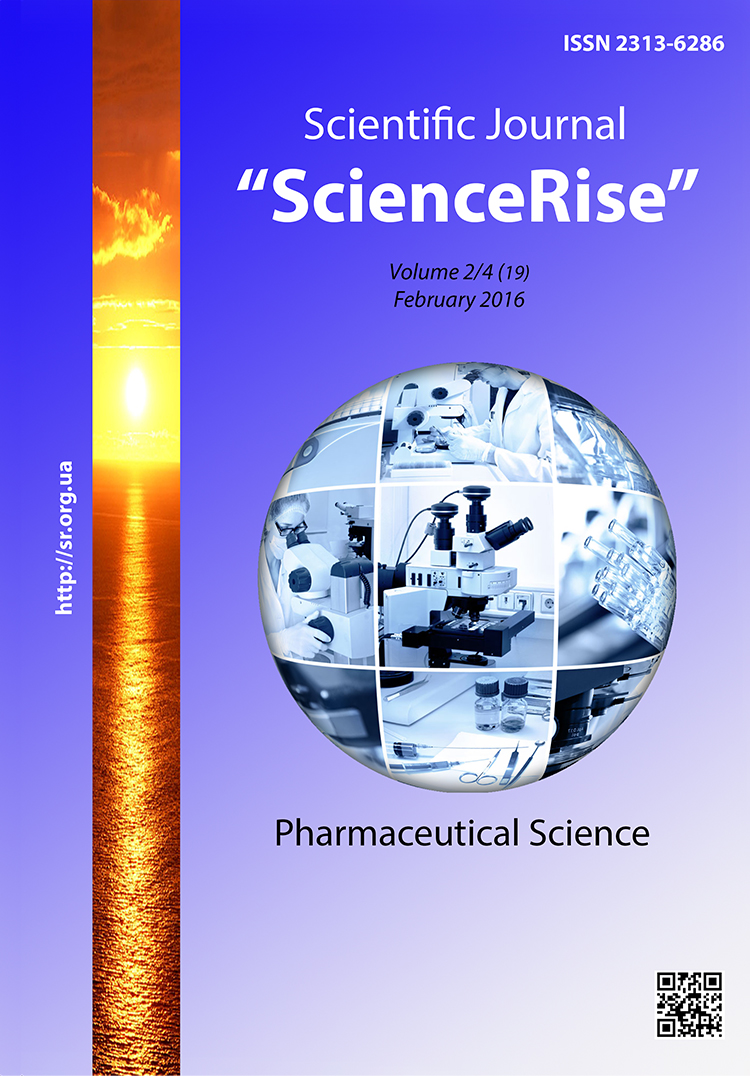In silico approaches for rational design of potential anticonvulsants among 5-substituted 2-(R-amino)-1,3,4-thiadiazoles
DOI:
https://doi.org/10.15587/2313-8416.2016.61078Keywords:
"structure – activity" quantitative dependence, molecular descriptors, 1, 3, 4-thiadiazole derivatives, anticonvulsant activityAbstract
Modern approaches to rational design of remedies, particularly, anticonvulsants as well, must include the use of computer analysis methods of correlations, in particular, (Q)SAR-analysis. Therefore, a series of promising anticonvulsants among 5-substituted 2-(r-amino)-1,3,4-thiadiazoles to detect the main descriptors, influencing activity, and obtained QSAR-models, which can be used in the targeted search of promising anticonvulsants, have been used by us.
Aim. The aim of the given manuscript was to detect correlations and to form on their basis recommendations concerning the rational design of anticonvulsant agents among 5-substituted 2-(r-amino)-1,3,4-thiadiazoles.
Methods. Hyper-Chem 7.5 and BuіldQSAR Software were used to calculate molecular descriptors and QSAR-models construction.
Results. The regression analysis with the use of experimentally determined parameters of the severity of seizures, duration of seizures, latency period and the percentage of animals survived as dependent variables, and calculated 3D descriptors of compounds’ molecules as independent variables has been carried out for detection of the informative molecular descriptors, showing most adequately the features of molecules, responsible for the manifestation of the anticonvulsant activity. The calculation of the mathematical multiparameter QSAR-models has been carried out for this purpose. It has been shown, that anticonvulsant activity of the analyzed substances depends on the energy values of limit molecular orbitals and octanol-water partition coefficient logP, and besides, the severity of seizures decreases and latency period increases with both lipophility values and molecule’s volume increasing. The increase of polarizability has negative impact on the anticonvulsant activity of the synthesized compounds. The duration of seizures and animal survival time are reduced with decreasing of ЕНВМОvalue, i.e. with increasing of quantities of negative energy values of the lower vacant molecular orbital, which corresponds to strengthening of electron properties of compounds.
Conclusion. A statistically significant number of QSAR-models intended for the pre-experimental prediction of the effective anticonvulsants with prescribed set of properties of 1,3,4-thiadiazole derivatives. The most important descriptors in "structure - activity" dependence, i.e. lipophility, energy values of the lower vacant molecular orbital and molecular volume, have been determined by regression analysis for the given group of substances
References
Tetko, I. V., Gasteiger, J., Todeschini, R., Mauri, A., Livingstone, D., Ertl, P. et. al (2005). Virtual Computational Chemistry Laboratory – Design and Description. Journal of Computer-Aided Molecular Design, 19 (6), 453–463. doi: 10.1007/s10822-005-8694-y
Perekhoda, L. O., Georgiyants, V. A., Ribalchеnkо, Т. L., Plys, S. V. (2009). Protysudomna aktyvnist dymetylovykh esteriv 1-aryl-1,2,3-triazol(1H)-4,5-dykarbonovykh kyslot ta yii zalezhnist vid molekuliarnoi budovy [Anticonvulsant activity of methyl esters of 1-aryl-1,2,3-triazoles (1H) -4,5-dicarboxylic acid and its dependence on molecular structure]. Clin. pharm., 13 (3), 67–70.
Perekhoda, L. O., Severina, H. I., Georgiyants, V. A., Hrynenko V. V. (2011). Farmakolohichni vlastyvosti triazolopirymidynu ta kil'kisni spivvidnoshennya «struktura–protysudomna aktyvnist'» [Pharmacological properties of derivatives tryazolopirimidines and quantitative ratio «structure-anticonvulsant activity»]. Med. chem., 13 (2), 79–83.
Perekhoda, L. O., Georgiyants, V. A. (2011). Vyznachennia koreliatsii «struktura–protysudomna aktyvnist» v riadu pokhidnykh 1-aryl-4-R-5-metyl(amino)-1,2,3-triazolu(1H) [Definition of correlation «structure–anticonvulsant activity» of the derivatives of 1-aryl-4-R-5-methyl(amino)-1,2,3-tryazol(1Н)]. Clin. Inform. Telemed., 8, 93–97.
Perekhoda, L. O. (2012). QSAR-analiz pokhidnykh 1,2,3-triazolu(1H), shcho proiavliaiut protysudomnu aktyvnist [QSAR-analysis of l,2,3-triazol(1Н) derivatives revealing the anticonvulsant activity]. News of pharmacy, 1 (69), 54–56.
Perekhoda, L. O. (2013). Kolychestvennoe yssledovanye vzaymosviazy «struktura – protyvosudorozhnaia aktyvnost» v riadakh proyzvodnykh 1,2,3-tryazola(1H), 1,2,4-tryazola(4H), 1,3,4-oksadyazola(1H) i 1,3,4-tyadyazola(1H) [Quantitative study of «structure – anticonvulsant activity» relationship in series of 1,2,3-triazole (1H), 1,2,4-triazole (4H), 1,3,4-oxadiazole (1H) and 1,3,4 thiadiazol (1H)]. Pharm. Chem. J., 47 (11), 42–44.
Sych, I. V., Perekhoda, L. A., Tsapko, T. O. (2015). Synthesis of 5-substituted 1,3,4-thiadiazol-2-yl-sulfanylacetic acid derivatives. Scripta Scientifica Pharmaceutica, 2 (2), 53–59. doi: 10.14748/ssp.v2i2.1404
Sych, I. V., Perekhoda, L. A., Erjomina, Z. G. (2015). Syntez, fizyko-khimichni vlastyvosti ta prohnoz biolohichnoyi aktyvnosti novykh pokhidnykh 2-R1-N-(5-R)-1,3,4-tiadiazol-2-il-benzolsul'fonamidiv [Synthesis, physicochemical properties and prediction of biological activity of new derivatives of 2-R1-N-(5-R)-1,3,4-thiadiazol-2-yl-benzensulfonic acid amides]. Annals of Mechnikov institute, 4, 75‑81. Available at: http://nbuv.gov.ua/UJRN/ami_2015_4_12
Todeschini, R., Consonni, V. (Eds.) (2009). Molecular Descriptors for Chemoinformatic. Weinheim: Wiley-VCH, 1257. doi: 10.1002/9783527628766
HyperCube, Inc.: Hyperchem software. Available at: http://www.hyper.com
Lipinski, C. A., Lombardo, F., Dominy, B. W., Feeney, P. J. (1997). Experimental and computational approaches to estimate solubility and permeability in drug discovery and development settings. Advanced Drug Delivery Reviews, 23 (1-3), 3–25. doi: 10.1016/s0169-409x(96)00423-1
De Olivera, D. B., Gaudio, A. C. (2000). BuildQSAR: A new computer program for QSAR analysis. Quantitative Structure-Activity Relationships, 19 (6), 599–601. doi: 10.1002/1521-3838(200012)19:6<599::aid-qsar599>3.0.co;2-b
Habibi-Yangjeh, A., Pourbasheer, E., Danandeh-Jenagharad, M. (2008). Prediction of basicity constants of various pyridines in aqueous solution using a principal component-genetic algorithm-artificial neural network. Monatshefte für Chemie – Chemical Monthly, 139 (12), 1423–1431. doi: 10.1007/s00706-008-0951-z
Downloads
Published
Issue
Section
License
Copyright (c) 2016 Ліна Олексіївна Перехода, Ірина Володимирівна Драпак, Ігор Володимирович Сич, Тетяна Олександрівна Цапко

This work is licensed under a Creative Commons Attribution 4.0 International License.
Our journal abides by the Creative Commons CC BY copyright rights and permissions for open access journals.
Authors, who are published in this journal, agree to the following conditions:
1. The authors reserve the right to authorship of the work and pass the first publication right of this work to the journal under the terms of a Creative Commons CC BY, which allows others to freely distribute the published research with the obligatory reference to the authors of the original work and the first publication of the work in this journal.
2. The authors have the right to conclude separate supplement agreements that relate to non-exclusive work distribution in the form in which it has been published by the journal (for example, to upload the work to the online storage of the journal or publish it as part of a monograph), provided that the reference to the first publication of the work in this journal is included.

